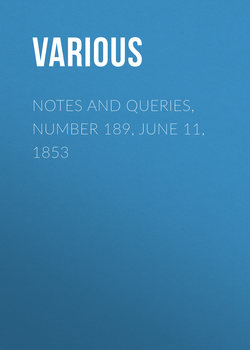Читать книгу Notes and Queries, Number 189, June 11, 1853 - Various - Страница 1
Notes
TOM MOORE'S FIRST!
ОглавлениеIt is now generally understood that the first poetic effusion of Thomas Moore was entrusted to a publication entitled Anthologia Hibernica, which held its monthly existence from Jan. 1793 to December 1794, and is now a repertorium of the spirited efforts made in Ireland in that day to establish periodical literature. The set is complete in four volumes: and being anxious to see if I could trace the "fine Roman" hand of him whom his noble poetic satirist, and after fast friend, Byron, styled the "young Catullus of his day," I went to the volumes, and give you the result.
No trace of Moore appears in the volume containing the first six months of the publication; but in the "List of Subscribers" in the second, we see "Master Thomas Moore;" and as we find this designation changed in the fourth volume to "Mr. Thomas Moore, Trinity College, Dublin!" (a boy with a black ribband in his collar, being as a collegian an "ex officio man!"), we may take it for ascertained that we have arrived at the well-spring of those effusions which have since flowed in such sparkling volumes among the poetry of the day.
Moore's first contribution is easily identified; for it is prefaced by a note, dated "Aungier Street, Sept. 11, 1793," which contains the usual request of insertion for "the attempts of a youthful muse," &c., and is signed in the semi-incognito style, "Th-m-s M—re;" the writer fearing, doubtless, lest his fond mamma should fail to recognise in his own copy of the periodical the performance of her little precocious Apollo.
This contribution consists of two pieces, of which we have room but for the first: which is a striking exemplification (in subject at least) of Wordsworth's aphorism, that "the child is father to the man." It is a sonnet addressed to "Zelia," "On her charging the author with writing too much on Love!" Who Zelia was—whether a lineal ancestress of Dickens's "Mrs. Harris," or some actual grown up young lady, who was teased by, and tried to check the chirpings of the little precocious singing bird—does not appear: but we suspect the former, for this sonnet is immediately followed by "A Pastoral Ballad!" calling upon some Celia unknown to "pity his tears and complaint," &c., in the usual namby-pamby style of these compositions. To any one who considers the smart, espiègle, highly artificial style of "Tom Moore's" after compositions, his "Pastoral Ballad" will be what Coleridge called his Vision, a "psychological curiosity."
Passing on through the volumes, in the Number for February 1794 we find a paraphrase of the Fifth Ode of Anacreon, by "Thomas Moore;" another short poem in June 1794, "To the Memory of Francis Perry, Esq.," signed "T. M.," and dated "Aungier Street." These are all which can be identified by outward and visible signs, without danger of mistake: but there are a number of others scattered through the volumes which I conjecture may be his; they are under different signatures, generally T. L., which may be taken to stand for the alias "Thomas Little," by which Moore afterwards made himself so well known. There is an "Ode to Morning," in the Number for March 1794, above the ordinary run of magazine poetry. And in the Number for May following are "Imitations from the Greek" and Italian, all under this same signature. And this last being derived from some words in Petrarch's will, bequeathing his lute to a friend, is the more curious; and may the more probably be supposed Moore's, as it contains a thought which is not unlikely to have suggested in after years the idea of his celebrated melody, entitled the "Bard's Legacy." The Number for Nov. 1794, last but one in the fourth volume, contains a little piece on "Variety," which independent of a T. M. signature, I would almost swear, from internal evidence, to be Moore's; it is the last in the series, and indicates such progress as two years might be supposed to give the youthful poet, from the lack-a-daisical style of his first attempts, towards that light, brilliant, sportive vein of humour in which he afterwards wrote "What the Bee is to the Flowret," &c., and other similar compositions. I now give Moore's first sonnet, including its footnote, reminding us of the child's usual explanatory addition to his first drawing of some amorphous animal—"This is a horse!" or "a bear!" as the case may be. Neither the metre nor the matter would prepare us for the height to which the writer afterwards scaled "the mountain's height of Parnassus:"
"To Zelia
(On her charging the Author with writing too much on Love.)
'Tis true my Muse to love inclines,
And wreaths of Cypria's myrtle twines;
Quits all aspiring, lofty views,
And chaunts what Nature's gifts infuse:
Timid to try the mountain's* height,
Beneath she strays, retir'd from sight,
Careless, culling amorous flowers;
Or quaffing mirth in Bacchus' bowers.
When first she raised her simplest lays
In Cupid's never-ceasing praise,
The God a faithful promise gave—
That never should she feel Love's stings,
Never to burning passion be a slave,
But feel the purer joy thy friendship brings.
* Parnassus!"
If you think this fruit of a research into a now almost forgotten work, which however contains many matters of interest (among the rest, "The Baviad of Gifford"), worth insertion, please put it among "N. & Q.;" it may incite others to look more closely, and perhaps trace other "disjecta membra poetæ."
A. B. R.
Belmont.
